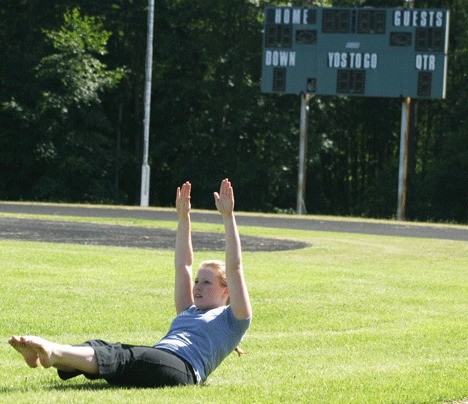LANGLEY — It’s softer, almost bouncy. The green color never fades, it doesn’t need water or mowing and boosters claim the stuff allows athletes to pivot on the run without causing serious injury.
But, boy, is it expensive.
Current estimates for replacing grass with artificial FieldTurf and a new track surface at Waterman Field run about $1.5 million. Following a great deal of study and discussion, South Whidbey School District officials decided to add the new turf and a middle school-dedicated gym to the $25 million bond request headed to voters on Nov. 2.
The 20-year bond is designed to pay for seismic upgrades, building repairs, improvements and remodeling at the high school. The board voted last year to close Langley Middle School and move all sixth- to eighth-grade students and programs to the high school campus by the fall of 2012.
When they get there, athletic facilities will be stretched, said high school athletic director John Patton.
“We are lacking outdoor field space,” he said. “We currently don’t have the space to house our outdoor middle and high school sports and physical education classes when consolidation occurs.”
By adding artificial turf, the all-weather playing surface can be used year-round. Sports programs affected include multi-grade boys and girls soccer, track and cross country, football and the many community teams that use the field in the summer and on weekends.
“Currently, due to the wear and tear and condition of the field, we can only have games on our stadium field, not practices,” Patton added. “This new surface will maximize our playing time and has the potential to increase revenue generation.”
FieldTurf is a polyethylene and polypropylene blend that looks and feels like natural grass. The surface is filled about 2 inches deep with a combination of silica sand and rubber grains with ¾-inch of grass at the top. The grass is then brushed to split the long blades into smaller, more natural-looking pieces. Water drains through the field, so it’s not slippery, and snow can be brushed off or removed with a rubber-bottomed snowplow, if necessary.
This cushion improves safety when compared to earlier artificial surfaces, and allows players to plant and pivot as if they were playing on a grass field. Proponents of the surface, including Falcon football co-coach Andy Davis, also cite the turf’s low-cost maintenance and durability.
“A turf field is needed to maintain our whole sports program,” he said. “We’re going to see almost double the number of kids on the field in two years.”
Other advantages of FieldTurf include the elimination of fertilizer run-off and the utilization of discarded tires; all materials are recyclable. Costs related to painting, fertilizer, soil, seed and labor are substantially reduced, supporters say.
“And overall, it reduces the carbon footprint, so it’s ecologically sound,” Patton added.
More to the point, studies have shown the surface decreases neural and cranial injuries and lowers the amount of time athletes are out of class.
Within the past five years, high schools in Oak Harbor, Cedarcrest and Sultan have added FieldTurf.
“They’ve all experienced fewer injuries since the new surface was added,” Davis noted. “The amount of time lost by athletes who have had to stay out of school is down at every school with FieldTurf.”
Monday, King’s High School cheer captain Kate Watters — whose family owns a cabin on Whidbey — was practicing her moves on Waterman Field. The school, a Cascade Conference competitor, installed FieldTurf three years ago.
“When the new turf was put in, everyone one seemed to like it,” she recalled. “Our teams were basically playing in the mud, so the FieldTurf helped stop some injuries. It’s working out well.”
If South End voters approve the bond measure, the school also plans to relocate the long-jump, high jump and shot put areas, plus add more fencing and walkways for security and better access. The cracked surface around the stands will be upgraded and the track itself resurfaced.



